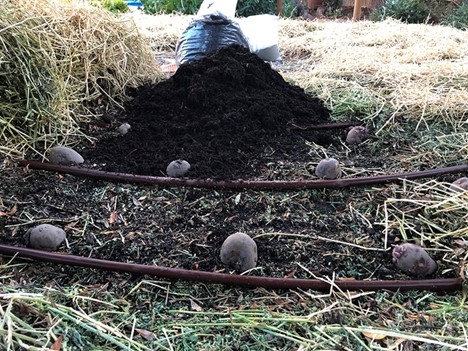UC Blogs
Growing Potatoes Two Ways in the Home Garden
When I first started growing vegetables at home, potatoes seemed like they would be impossible or gross. I didn't like the idea of digging them up and having to wash them endlessly before cooking them. I don't usually peel potatoes I buy from the store, so washing would be extra work.
It turned out there are more ways to grow potatoes than burying them under the dirt, and I tried one of them. And last year I finally got around to planting them in the ground and dealing with the mess of digging hem up. There are definitely pros and cons to both approaches. If you'd like to try potatoes yourself, this article might give you a head start.
How to plant and grow potatoes
First of all, let's clear up what we mean when we say seed potatoes. It's not seeds, like tomato seeds or corn seeds. Seed potatoes are actual potatoes that you plant. You order seed potatoes by weight. My order this year was for 2.5 pounds of two varieties.
Actual potato seeds are something else completely. That's called true potato seed, TPS for short. These are seeds harvested from the fruits of potato plants. Those fruits look like tiny tomatoes that mostly stay green or purple, though not all varieties of potato plant produce fruit.
Do not eat potato plant fruits—they are poisonous.
Planting seed potatoes—which are just, well, potatoes—is pretty simple. You can plant the entire potato in the ground an inch or two deep and call it good. If you'd like to try and boost your productivity with more individual plants, you can cut up each seed potato into smaller pieces as long as each piece has at least one eye.
The eye of the potato is a bud that pushes out the stem that will become the plant above ground. Without an eye on the piece of potato that goes in the ground, you're just feeding worms. Also, when cutting up a potato to plant it's important to let the cut side callus (dry) for a few days before going into the ground to reduce the risk of rotting.
It's at this point, when the potatoes are callused and ready to touch soil, that you've got some planting choices. The only mandatory aspect of planting is to ensure the new potatoes that you eventually harvest don't get any direct sunlight. Sunlight increases production of solanine, which is toxic.
Potatoes are a pretty easy crop. They can grow in pots as well as in the ground. People have planted them in towers of straw, which I guess is fine unless summer temps get so high that they suck out all the moisture. Otherwise, a lot is possible.
Planting potatoes under deep mulch
This approach to growing potatoes is relatively simple, and it was the first method I ever tried with potatoes. I did it because I didn't want to have to dig them out of the ground. I also read a number of blog posts across the web that made it seem like such an easy—and clean—way to grow and harvest potatoes.
First, you amend the soil however you normally would before planting. For me, this is a top dressing of composted manure a few weeks before the soil warms up. Then you place the pieces of potato—callused, cut side down—right on the surface of the soil. Cover that with a deep mulch. I prefer alfalfa straw, because it's high in nitrogen and it has no grass or weed seeds in it.
Did growing under deep mulch work as the Internet promised it would? Yes and no. It was easy, that much is true. I pulled back the straw and there were my potatoes. I picked them up and put them in a bucket. They were also pretty much clean. Most were pristine, actually.
Production was overall incredible. Total yield was roughly ten times the weight of what I planted, though I lost some of this to greening from sun exposure. I wrote all about this experience a couple years ago.
Downside? Pillbugs and earwigs also got their share. This is the downside in general of gardening under deep mulch. It's a breeding ground for pillbugs and earwigs.
The year after this experience I had the bright idea to completely cover the seed potatoes with compost from my own compost bin, and then cover that with deep alfalfa mulch. My yields were awful! This was entirely because throughout that beautiful black compost were more earwigs and pillbugs than I imagined possible.
Planting potatoes in the dirt
Last year, I gave in and planted my seed potatoes the way it seemed everyone else did. I dug little holes beside my irrigation line emitters and I planted them. Part of this felt like giving up. I would have filthy potatoes and I would have to peel them before I ate them. What fun I would have at the end of the season!
Those plants grew exceptionally well. They were veritable shrubs, and they leafed out earlier than everything else in in the spring. I planted two varieties, 'Purple Viking' and 'Blackberry'. 'Blackberry' came as microtubers, which are tiny little seed potatoes produced by tissue cultures instead of potatoes kept from a prior crop.
All together I planted 2.5 pounds of Purple Viking and ten 'Blackberry' potato microtubers. I weighed out most of the potatoes I harvested and by the end of the season counted up 16 pounds. That's a roughly 5x return from seed potatoes to dinner, not countings the ones I pulled early as new potatoes. Growing in the ground, I lost nothing to the pillbugs and earwigs.
Great, if dirty, potato yields
So what made the difference in yields? None of my thoughts on this would be scientific. They would not based on any comparison between the same seed potatoes grown in two different conditions.
That means the difference in yields could have been caused by a lot of things, from the quality of the seed potatoes themselves to more observable differences like different amounts of water, fertility or sunlight. That means it's impossible to attribute the difference in yields to the planting method itself.
It also doesn't really matter, not to me as long as I don't lose everything to pillbugs and earwigs. That's the luxury of being a home gardener. Whether yields are good or bad, it's all gardening.
What I do know is that I pulled out some pretty dirty potatoes, and I ended up peeling them before cooking. The meals they made were, of course, amazing. As I write this, I'm waiting for this year's seed potatoes to arrive.
Additional resource on potato growing from UC Santa Cruz: https://agroecology.ucsc.edu/resources/publications/grower-guides/pdf-downloads/potatoes.pdf
There Is No Planet 'B'
There is no "Planet B." The Earth is all we have. Today, April 22, is Earth Day (an annual event launched April 22, 1970) and what a perfect...
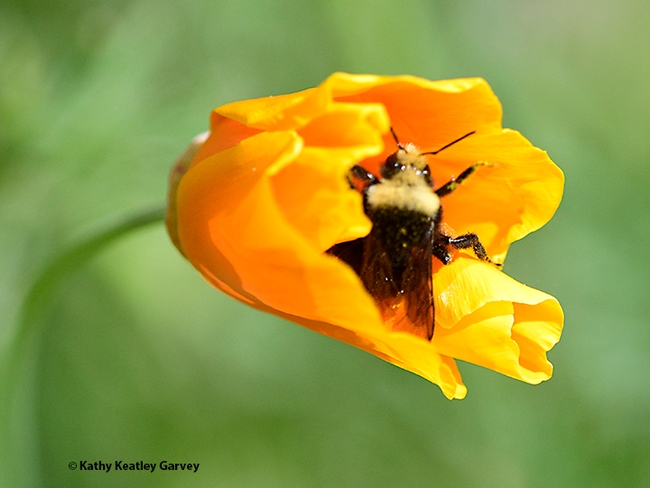
A yellow-faced bumble bee,Bombus vosnesenskii, buzzes into a barely opened California golden poppy in a Vacaville garden. (Photo by Kathy Keatley Garvey)
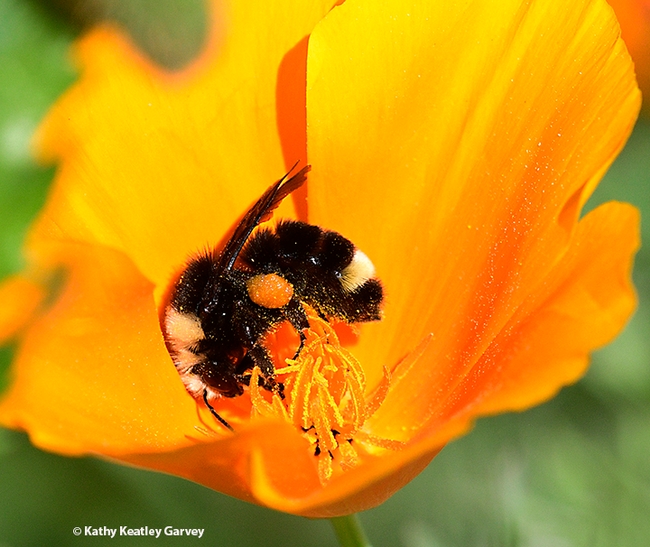
Check the orange pollen on this yellow-faced bumble bee, Bombus vosnesenskii(Photo by Kathy Keatley Garvey)
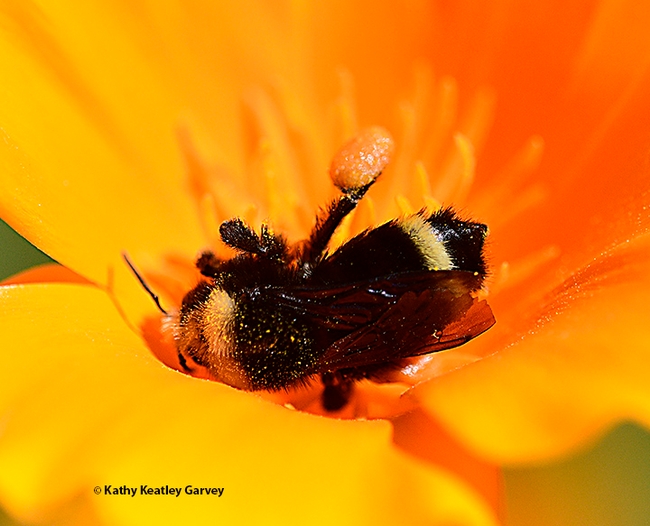
And we have a lift-off! The pollen basket is easily recognized here. (Photo by Kathy Keatley Garvey)
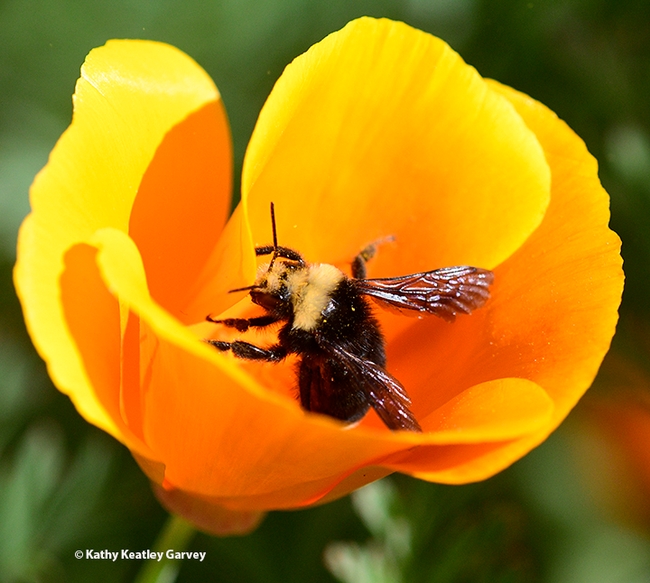
Ready for take-off! The bumble bee, Bombus vosnesenskii, prepares to leave the California golden poppy. Both are natives. (Photo by Kathy Keatley Garvey)
All the 'Bugs' at UC Davis Picnic Day Will Be at Briggs Hall
Wait! Don't head over to the Bohart Museum of Entomology in the Academic Surge Building on Crocker Lane on Saturday, April 20 during the...
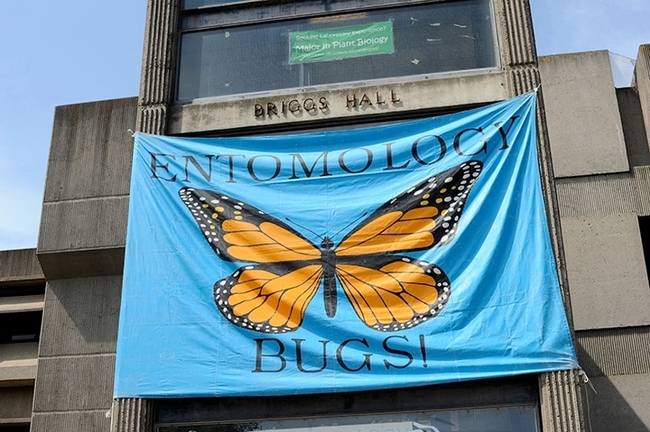
A monarch banner beckons visitors to Briggs Hall, home of the UC Davis Department of Entomology and Nematology. (Photo by Kathy Keatley Garvey)
Diversity of Arachnids to be Showcased at Briggs Hall During UC Davis Picnic Day
The UC Davis Department of Entomology and Nematology will not only celebrate insect and nematode diversity at Briggs Hall during the 110th...
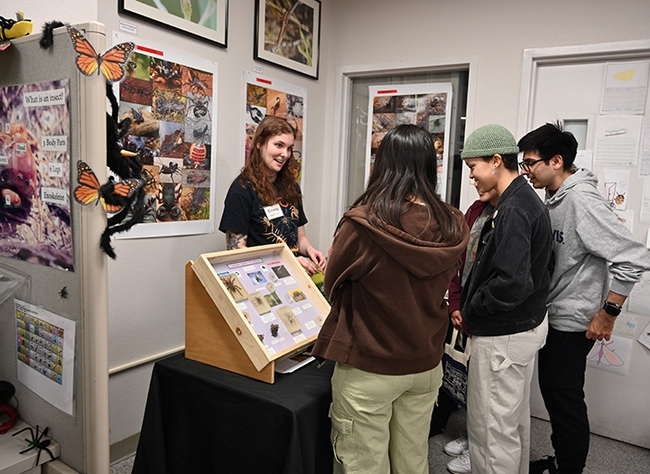
UC Davis doctoral student Emma Jochim discusses arachnids at a Bohart Museum of Entomology open house. She'll be showing the diversity of arachnids at Briggs Hall during UC Davis Picnic Day on Saturday, April 20, with colleagues. (Photo by Kathy Keatley Garvey)
UC Davis Picnic Day: The Art of Fly-Tying
Ever seen an angler tie a fly? You will if you visit Briggs Hall during the 110th annual UC Davis Picnic Day on Saturday, April 20. "The Art of Fly...
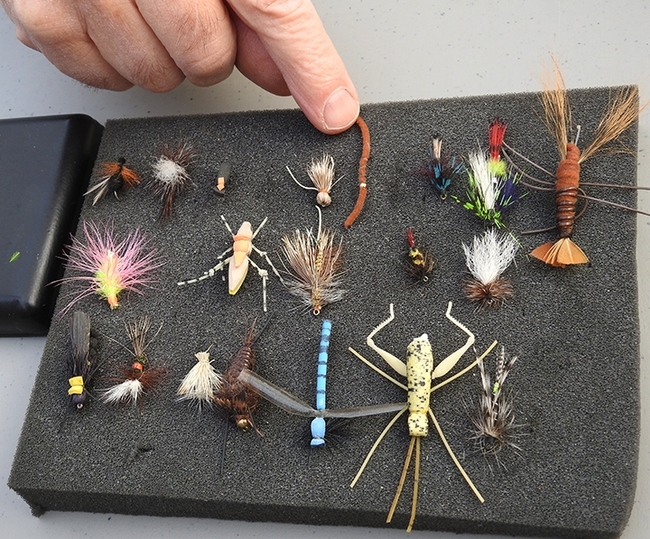
A display by the Fly Fishers of Davis at a recent UC Davis Picnic Day. The Fly Fishers are an integral part of the insect activities at Briggs Hall, home of the UC Davis Department of Entomology and Nematology. (Photo by Kathy Keatley Garvey)
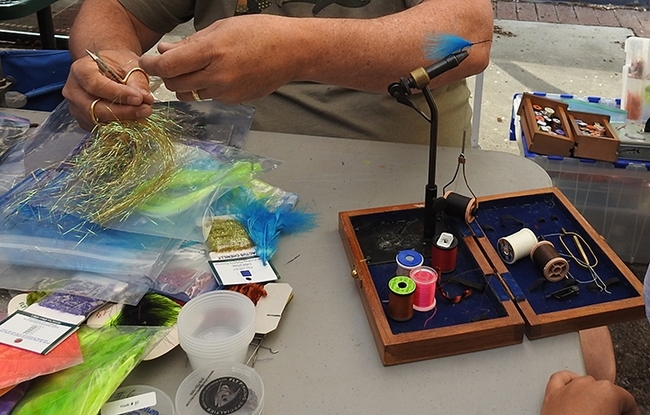
The art of tying a fly by the Fly Fishers of Davis. (Photo by Kathy Keatley Garvey)
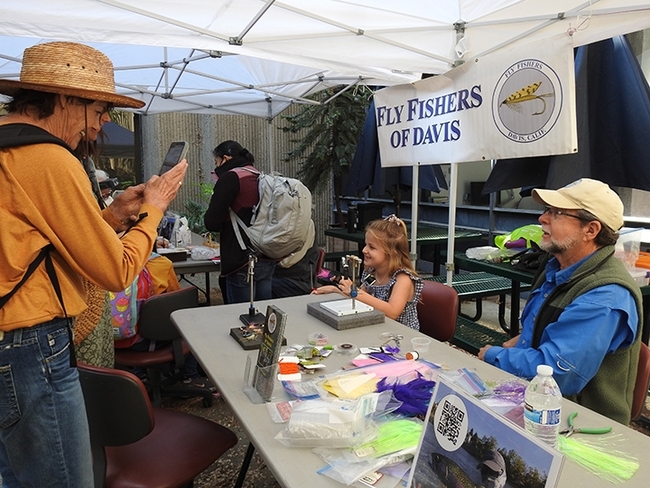
At the end of a mini-session with Paul Berliner (right) of the Fly Fishers of Davis, it's family photo time. (Photo by Kathy Keatley Garvey)


